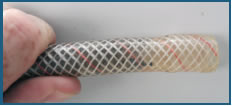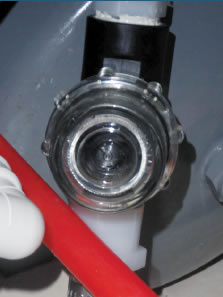

Ever find a bug doing the backstroke in your water tank? We have.
Would you leave a glass of water sitting uncovered for weeks and then come back to it? Of course not, but many builders either lead the hose to a mushroom-type through-hull fitting, or terminate it inside the cabin, with nothing to keep the ubiquitous critters from seeking shelter, fresh water, or a nesting site.
We recommended vent filters for gasoline and fuel tanks (see PS, January 2014 online); keeping the water out pays benefits in reduced corrosion, evaporation, microbe growth, and engine maintenance. We recommended vent filters for holding tanks, when natural ventilation and chemical treatment just arent enough (see PS, March 2012 online). So of course, we recommend screens for your freshwater tank vent.
The plumbing code requires a minimum of size 16 mesh screening (1 millimeter sieve size) on all portable water storage tanks. This can be in the form of a screen on the through-hull fitting or an in-line strainer. In addition, the vents should be facing downward and baffled so that dust cannot blow into them. While dust isn’t a risk for sailors, seawater is if vents are not wisely located; many sailors have had their tanks contaminated by salt water after a knockdown or prolonged periods of bad weather.
Our recommendation? If you have a through-hull vent, installing an inline strainer is inexpensive and easy. Confirm that there is a high loop to prevent seawater intrusion. If the vent terminates inside, determine whether the location is really suitable; if the tank overfills, is the boat going to flood? Is the location relatively clean? This may be a good time to relocate the vent.
If you chose a through-hull location, there are many fuel tank vents that will work. Since the vent outlet on our test boat was through a mushroom through-hull fitting, we chose a small, in-line strainer (Shurflo 255-323, 50 mesh, $12) as a simple retrofit solution and have been pleased. The filter is inexpensive, takes just minutes to install, and is easier to clean than the through hull. Forespar, Vetus, and Whitecap Industries also sell inline filters. For internal vents, something as simple as taping gauze over the hose end can do a superior job.
































